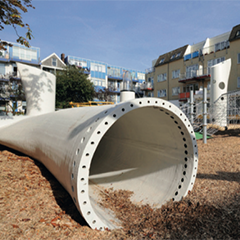The CompositeLoop project is a feasibility study that proposes short term solutions in Flanders, Belgium for the valorisation of large thermoset end-of-life GFRP (glass fiber reinforced plastics) structures such as wind turbine blades, boats and yachts, profiles, silos. The study is based on literature review and input captured during three interactive workshops with stakeholders over the entire decommissioning to waste valorisation value chain. It identifies promising local short-term scenario’s, with the purpose of initiating synergies within the value chain, allowing further technical and commercial development of recycling solutions as a next phase.
1 Large GFRP structures with fast-growing waste volumes
Wind energy is the strongest renewable energy source currently in Europe and it will only increase because to reach the EU goals of 32% renewable energy by 2030, significant increase in wind power capacity is required. Wind turbines are being built since 1980s and boomed around 90s and 00s. They have 20-25 years of lifetime. Thinking about the development in wind energy in the last 40 years, it is understandable that every year more wind turbines are reaching their end of life. In 2018 alone, total of 421MW of wind power was decommissioned where 14MW was from offshore wind plants1.
The expected blade waste till 2050 is shown in Figure 1. In Belgium, these volumes are quite limited compared to the whole Europe. In the CompositeLoop project, it is predicted that in 2035 about 4000 tonnes of blade waste will be available in Belgium by considering the existing wind farms and their commissioning years. The wind turbine blades are mostly composed of GFRP, the internal lay-up usually consists of different layers and fiber directions of glass fiber and other materials such as balsa, some metals at the root and coatings as well. This variation and the internal layup have no standard distribution; it changes from one blade to another. This makes recycling of the blades quite challenging.
It is estimated that 6 million recreational boats exist in Europe alone. With boat lifespans of 30-45 years, some 140,000 of these vessels per year can be expected to become due for scrapping. Most will be composite and the majority of those will be GFRP. Since 140,000 vessels are expected to be end of life per year, many initiatives have described a way forward for the recycling of boats. For example, researchers of the BOATCYCLE project in Spain and Italy, calculated that the average cost of conventionally dismantling a 7 m long boat, including logistics, is €800, rising to some €1500 for a 10-12 m craft and €15,000 for a 15 m vessel.



























